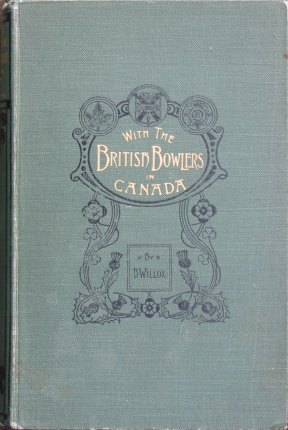| Title | With the British Bowlers in Canada, 1906 | ||
| Author | Bailie D Willox | ||
| Publisher | D Gilfillan & Co, Glasgow, Scotland | ||
| First published | Not stated, but probably 1907 | ||
| ISBN | Pre-ISBN system | ||
| Edition reviewed | 1st | ||
| Hardback/softback | Hardback | ||
| List price | Not known | ||
| Cover size (cm) (height x width) |
22.3 x 14.0 | ||
| Number of pages | 262 | ||
| Number of pages with | Coloured photos | Black & white photos | Line drawings |
| None | 23 | 19 | |
| Synopsis | With the British Bowlers in Canada, 1906 describes in great detail and in the engagingly worded prose of a century ago the tour undertaken by the first British bowls team to visit Canada. The travelling party consisted of 43 players with an average age of 55 and the eldest 83. Twenty-six came from Scotland and ten from England.
Every aspect of the tour is covered comprehensively, from the preparations, to the journey by boat, the travel within Canada, the social programme and, of course, the matches against Canadian teams. To give you a flavour of the book's style and how the game was played then - at least on this tour - here's an extract from notes taken at one of the matches: Canadian bowling is somewhat automatic. The skip does the talking, except in cases where his third player finds fault with his judgment, and the player trundles his two bowls and goes and sits down or seeks encouragement at the refreshment booth. In British bowling, and particularly Scotch bowling, every member of the rink talks, talks, talks. The vice-skip generally walks down the rink after an end with his skip. They stop talking together when the jack is thrown. The lead joins them when he has played, and then they all talk - talk to the player in low, reproachful tones if he is wide or narrow; in high-pitched tones of exultation if he is on the jack; and all this talk in brands of Scotch that mellows the evening air like the first faint odour from a pot of porridge. Twenty-three matches were played between 28 July and 27 August, of which 21 were won and two lost. The matches are recorded in detail - even down to the score by ends. This book is a treat for bowls historians and will provide fascinating reading for many others. |
||



